Pilot’s Secret for a Smooth Flight: Sit Here. Most Passengers Never Think of It
If turbulence stresses you out, here's the seat I'd choose as a passenger. Most never think of it.
If turbulence stresses you out, here's the seat I'd choose as a passenger. Most never think of it.
You're 35,000 feet up when the seatbelt sign dings on. The captain's voice crackles through the intercom: "Folks, we're expecting some chop ahead." Your knuckles go white on the armrest as the plane starts its familiar dance that stomach-dropping, teeth-rattling reminder that you're hurtling through the sky in a metal tube.
But here's what I learned after 25+ years in the cockpit: not all seats are created equal when it comes to turbulence.
The Physics of Flight (And Why Your Seat Choice Matters)
Think of an airplane like a seesaw balanced on a fulcrum. That fulcrum? It's roughly at the wing's center of lift. When turbulence hits, the plane pivots around this point. Sit at the nose or tail, and you're riding the extreme ends of that seesaw every bump gets amplified. But sit near the wings, and you're as close to the pivot point as possible.
It's basic physics, yet most passengers instinctively avoid wing seats. They want the view, or they think being over the wing means more noise. What they don't realize is they're choosing a rougher ride.
Keep reading with a 7-day free trial
Subscribe to Lessons From The Flight Deck to keep reading this post and get 7 days of free access to the full post archives.



